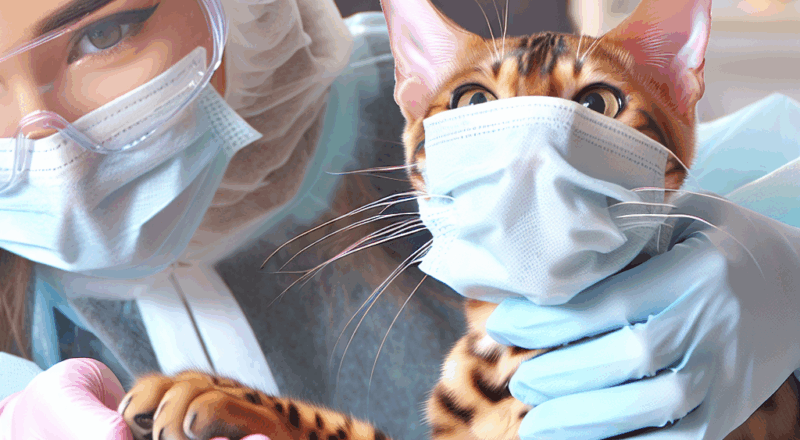Welcome to an in-depth exploration of the exquisite Bengal Cat, known for its striking appearance and playful demeanor. This guide aims to provide comprehensive insights into the Bengal, a breed that captivates both seasoned pet owners and curious new enthusiasts alike.
Origin and Appearance of the Bengal Cat
The Bengal Cat originated from the hybridization of domestic felines with the Asian leopard cat. This unique blend gives the Bengal its distinctive spotted or marbled coat reminiscent of its wild ancestors. Available in a variety of colors, including brown, silver, and snow, the Bengal’s coat is not only beautiful but also incredibly soft and sleek. Their muscular build and alert appearance make them stand out in any feline lineup.
| Characteristic | Description |
|---|---|
| Origin | Hybrid of domestic cat and Asian leopard cat |
| Coat | Spotted or marbled pattern |
| Colors | Brown, silver, snow |
| Build | Muscular and athletic |
Fun and Frolic: Popular Bengals’ Behaviors
Bengals are known for their high energy levels and playful nature. They enjoy activities that stimulate their minds and bodies, from interactive play sessions with toys to climbing adventures. They might chase laser pointers or engage with puzzle feeders for mental enrichment, proving their intelligence and curiosity.
Social Interactions: Alone vs. In a Group
Bengals thrive on social interaction. While they can be independent, they prefer being in the company of their human family or other pets. In multi-pet households, Bengals often establish playful hierarchies and enjoy engaging with their furry companions.
Interaction with Children and Adults
Bengals are generally excellent with children, being both tolerant and playful. Their boundless energy aligns well with a child’s enthusiasm, making them fantastic companions in families. Likewise, they form strong bonds with adults, often following them around the house like a shadow.
Nurturing a Bengal: Health and Nutrition
Proper nutrition is vital for maintaining the Bengal’s active lifestyle. A balanced diet of high-quality cat food, rich in protein, supports their muscular build. Regular veterinary check-ups and vaccinations are recommended to ensure optimal health.
Engaging Bengals in regular physical activities and maintaining mental stimulation is essential for their well-being. Consider investing in a variety of toys and interactive setups to keep them entertained.
Adopting a Bengal: Bringing Joy to Your Home
Adopting a Bengal can be a rewarding experience. Numerous rescues and shelters specialize in rehoming Bengals, making it easier for you to find your new furry friend. The benefits of adopting are not only profound for the cat but bring immense satisfaction and fulfillment to the adopter as well.
Managing Costs: Bengals and Your Budget
Owning a Bengal involves specific financial commitments. From quality food and health check-ups to grooming needs, it’s important to consider these aspects when budgeting. Bengal owners often find the investment worthwhile, given the immense joy and companionship these cats provide.
Animal Rights and Ethical Considerations
It’s crucial to respect and adhere to legislation regarding pet ownership. Ensuring that your Bengal is sourced from ethical breeders or adoption centers contributes to broader animal rights and welfare practices.
Learn More
Interested in providing your Bengal with a nutritious diet? Discover the secrets to a healthy, balanced diet tailored for your feline friend. Click the link below to access over 40 delicious, healthy recipes:
Discover the secrets for a healthy and balanced diet for your dog with over 40 delicious and healthy recipes
Click the image below to learn more about the product:
Here are 20 important facts:
- Bengal cats have a rich history linked to their wild ancestry.
- They are known to be talkative, communicating with a range of sounds.
- Bengals can be taught fetch, due to their dog-like retrieval instincts.
- They enjoy water and may play in sinks or bathtubs.
- Bengal grooming is minimal due to their short coat.
- These cats come alive at night and may take on nocturnal habits.
- They require a lot of attention and may develop problematic behaviors if bored.
- Bengals are excellent jumpers, able to reach high places effortlessly.
- They are prone to cataracts and hypertrophic cardiomyopathy if not carefully managed.
- Bengals create strong attachments with their human families.
- It’s important to Bengal-proof your home as they are explorers.
- Bengals love interactive toys that challenge their intelligence.
- Adoption of Bengals often involves thorough background checks.
- They may show their affection through kneading and gentle nibbles.
- Bengals are agile and sleek, designed for agility and speed.
- An identified diet and health plan should be customized for each Bengal.
- The Bengal’s pattern may evolve with age, revealing intriguing color changes.
- They thrive in structured, routine environments.
- An early socialization period is crucial for long-term behavioral health.
- Bengals combine the beauty of the wild with the temperament of the domestic, offering a unique pet-keeping experience.
The Bengal cat, with its striking appearance and captivating personality, has become one of the most popular breeds among pet enthusiasts worldwide. Known for their unique spotted coat that resembles that of a wild leopard, Bengals bring a mix of beauty, playfulness, and intelligence to the home. This comprehensive guide will explore everything there is to know about Bengal cats, their history, and tips for their care.
History of the Bengal Cat
The Bengal cat originated from a cross between domestic cats and the Asian leopard cat in the 1960s. Breeders aimed to create a breed that mirrored the exotic look of wild cats while being domesticated. This careful breeding process led to the development of the Bengal breed, which was officially recognized by cat registries in the 1980s.
Famous Bengal Cat Owners
One notable celebrity that has embraced the Bengal breed is singer and songwriter Mariah Carey, who owns a Bengal cat named Jack. Her extravagant lifestyle includes sharing her home with Jack, who often accompanies her on various travels and adventures.
Countries Where Bengal Cats Are Most Popular
| Country | Popularity |
|---|---|
| United States | High |
| Canada | High |
| United Kingdom | Medium |
| Australia | Medium |
| Germany | Medium |
Choosing the Right Pet
When considering a Bengal cat, potential owners should reflect on their lifestyle. Bengals are active and require plenty of space to roam and play, making them suitable for homes with a yard or ample indoor space for activities.
The Importance of Adoption
Adopting a Bengal cat can provide a loving home to an animal in need. Reputable shelters and rescues can help guide potential owners through the adoption process, ensuring the right match for both the cat and the family.
First Steps Upon Arrival
Preparing for a Bengal cat means creating a comfortable environment. This includes setting up a cozy bed, litter box, and food and water dishes in a quiet area of the home.
Proper Nutrition
Bengal cats require a balanced diet high in protein. Optimal feeding schedules vary, but two meals a day is typically recommended, with controlled portions based on the cat’s weight and lifestyle.
Hydration Needs
Fresh water must always be accessible for Bengal cats to stay hydrated and support their health.
Vaccinations and Deworming
Keeping up with vaccinations and regular deworming schedules is crucial for preventative health. A checklist with the recommended vaccination timeline should be maintained by the owner.
Regular Veterinary Check-Ups
Annual veterinary visits are essential for monitoring health concerns and early diagnosis of potential issues.
Hygiene and Grooming
Regular grooming sessions, including bathing, brushing, nail trimming, and ear cleaning, will help maintain a Bengal’s coat and promote hygiene.
Physical Exercise
Daily playtime is vital for the physical well-being of Bengal cats. Engaging them in interactive play not only provides exercise but also stimulates their minds.
Environmental Enrichment
Invest in toys and activities that challenge your cat’s intellect and problem-solving skills, which is especially crucial for the curious Bengal breed.
Socialization
Expose your Bengal cat to various people, environments, and other pets while they are young for a well-adjusted, friendly adult cat.
Basic Training
Bengal cats can learn basic commands and should be trained positively to foster good behavior and safety.
Managing Unwanted Behaviors
Identify and address issues such as aggression and separation anxiety early. Consulting with a veterinarian or animal behaviorist may be beneficial.
Identification
Ensure your Bengal cat has a collar with ID tags and consider microchipping for added security.
Home and Outdoor Safety
Take preventive measures against household hazards and ensure safe outdoor experiences to avoid accidents.
Legal Considerations
Familiarize yourself with local laws regarding pet ownership, ensuring responsible care and compliance with regulations.
Financial Responsibilities
Budget for ongoing expenses including food, vet visits, grooming, and supplies to ensure your cat’s health and happiness.
Emotional Benefits of Pet Ownership
Owning a Bengal cat can provide companionship, reducing stress and improving mental well-being for their owners.
Caring for Senior Cats
As Bengal cats age, they require special attention regarding diet, exercise, and health monitoring to accommodate their changing needs.
Handling Grief
Experiencing the loss of a beloved pet is a profound event. Seek support from friends, family, or professional services to navigate the grieving process.
Take Action!
If you’re interested in transforming the behavior of your Bengal cat or any dog, consider exploring our specialized program.



/hotmart/checkout_custom/10424f92-b07f-4561-bff4-bf470c0e4846/6t29rz3e.jpg)